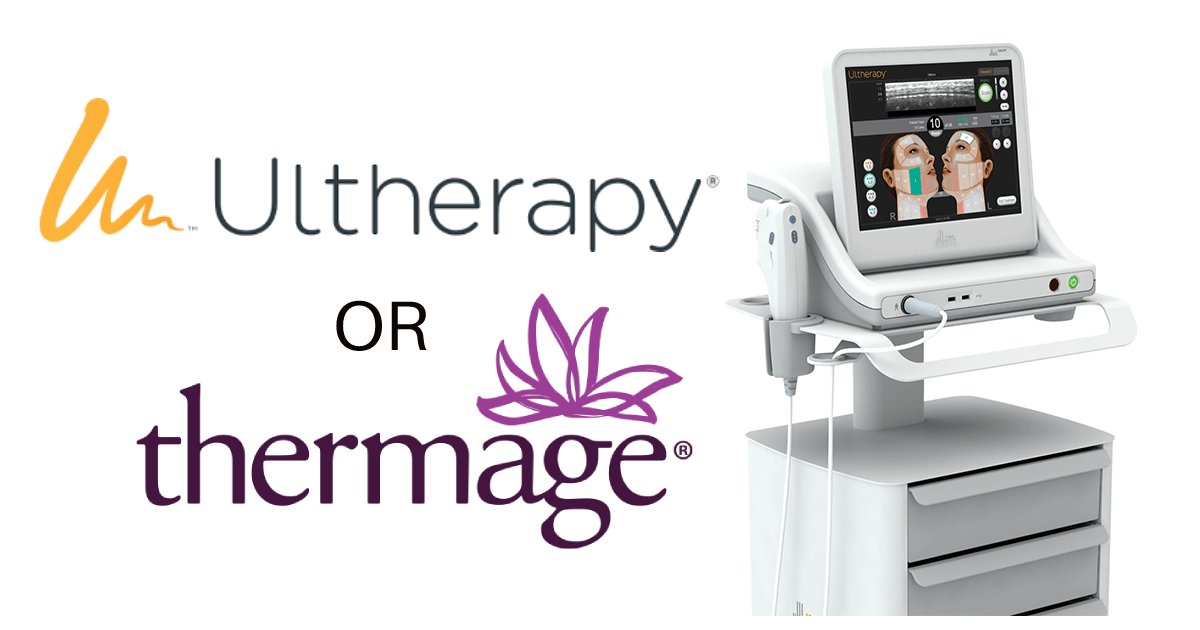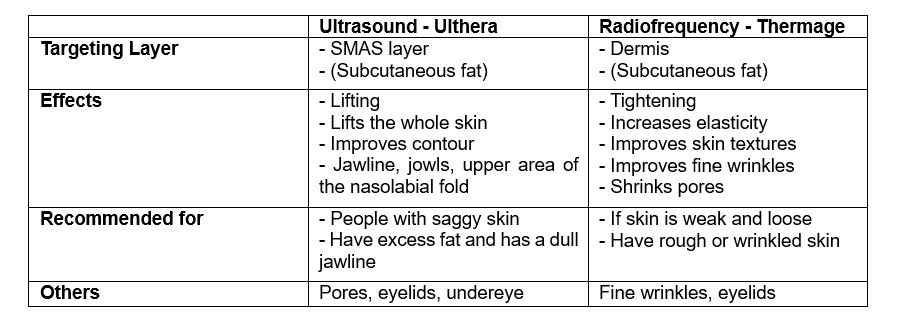Journal
Ultherapy VS Thermage: Which Lifting Procedure is Right for You?
2024-03-04
Anti-aging

In the ever-evolving landscape of non-invasive cosmetic procedures, two laser treatments stand out: Ultherapy and Thermage. These two pieces of equipment are the most popular and widely used in Korea for skin tightening, lifting, and addressing saggy skin. There are various lifting methods, so what is the difference between them, and what lifting approach is best for you?
What is Facelifting?
The term ‘facelift’ has traditionally been associated with surgical interventions aimed at lifting and rejuvenating the face. However, nowadays ‘facelift’ is growing vastly in dermatology, thanks to the advancement of less invasive procedures. So first, we will discuss the different lifting equipment in the field of dermatology.
With most skin treatments, dermatologists use Energy Based Devices (EBD). The energy is typically in the form of laser, radiofrequency, or ultrasound. The fundamental objective is to transfer controlled amounts of heat to the skin, strategically stimulating the production of collagen.
Collagen, a vital protein responsible for skin elasticity and firmness, experiences a natural decline with aging, contributing to the onset of sagging skin. Recognizing this, the primary goal of these advanced lifting devices in dermatology is to amplify and revitalize collagen production. By doing so, these treatments aspire to combat the signs of aging, effectively tightening and rejuvenating the skin.
For the radiofrequency method, the electrical currents pass through our skin with resistance. As the heat intensifies, skilled dermatologists strategically stimulate collagen production where needed, unlocking a rejuvenating cascade beneath the skin surface.
Much like radiofrequency, laser and ultrasound treatments also leverage the force of heat to elevate and rejuvenate the skin, each offering its unique approach to skin lifting through precision and targeted application.
Additionally, there are differences between various equipment and treatments depending on how much energy is delivered. The skin consists of three main layers, the epidermis(top), dermis(middle), and hypodermis (bottom or fatty layer). Underneath the subcutaneous fat and above the muscle layer is the SMAS layer. The SMAS layer is important because it connects the face and neck muscles to the skin and contains collagen, fibers, and connective tissues. So, depending on which layer the energy is displaced, we can get different lifting results.
Generally speaking, to lift saggy skin, the energy must penetrate the deepest layers and tissues, contracting the fascia layer to ensure an upward pull that defies the inevitable thinning and wrinkling of the outer skin. This precision targeting, often directed at the dermis layer, becomes a vital strategy in the quest for rejuvenation.
Equally crucial is the consideration of energy strength—how much, what kind, and how forcefully it is delivered. The lifting effect is intricately linked to the dispersion and intensity of the energy, whether it blankets a broad area or zeros in on specific regions.

What is Ultherapy?
Ultherapy stands at the forefront of non-invasive skin rejuvenation, wielding the power of High-Intensity Focused Ultrasound (HIFU) to redefine the contours of facial aesthetics. This advanced device employs a transducer to concentrate energy and heat on targeted areas of the skin. HIFU technology operates by inducing a shrinking effect through focused ultrasound energy. The transducer directs intense heat to a specific area, causing controlled damage to the skin. As the skin heals, fibroblasts kick into action, initiating a surge in collagen production. This excess collagen, in turn, tightens the skin, heralding a natural and gradual facelift effect.
What sets Ultherapy apart is its precision, facilitated by the adaptable tip of the device. The 1.5mm depth tip strategically addresses delicate areas, such as wrinkles near the eyes and pores, focusing more on improvement than lifting. On the other hand, the 4.5mm depth tip delivers heat to the deepest layers, precisely where the SMAS layer resides—typically around 4.5mm deep.
One of Ultherapy's unique strengths lies in its ability to provide dermatologists with a visual roadmap of the skin's interior layers through ultrasound imaging. This real-time visualization ensures accuracy in treatment, allowing dermatologists to navigate and tailor the procedure to the unique needs of each patient.
While Ultherapy primarily focuses on collagen stimulation, its impact extends beyond; when strategically placed on fat tissue, it can induce a beneficial shrinkage effect, sculpting the contours of the face.
While Ultherapy is a pioneer in the realm of HIFU, several other devices—such as Shrink, Tenthera, Doublo, Linear Firm, and more—also offer similar non-invasive skin rejuvenation options. The diversity in choices allows individuals to explore the solution that best aligns with their aesthetic goals and skin requirements.
What is Thermage?
In radiofrequency-based skin rejuvenation, Thermage stands as a prominent figure, utilizing its innovative approach to deliver transformative heat energy. However, Thermage is not alone in this pursuit, as several other devices, including Oligo, Tentermage, Tuneface, InMode, and more, join the ranks of cutting-edge solutions.
At its core, Thermage harnesses radiofrequency energy to generate controlled heat, redefining the landscape of non-invasive skin tightening. The key differentiator lies in its method of energy transfer – placing the tip or needle directly onto or into the skin. This direct approach ensures targeted and precise delivery of radiofrequency energy, setting the stage for a rejuvenating experience.
Tip Technology: Monopolar vs. Bipolar:
Thermage's tip technology plays a pivotal role in shaping its outcomes. The monopolar tip, widely employed in Thermage procedures, disperses energy across a broad area. In contrast, the bipolar tip, featuring two prongs, facilitates a back-and-forth transfer of radiofrequency energy. This nuanced choice in tip design allows practitioners to tailor treatments based on the desired outcome, whether it be widespread skin tightening or focused, localized rejuvenation.
Much like its counterpart Ultherapy, Thermage operates on the principle of stimulating collagen through the application of heat. As the radiofrequency energy permeates the skin, it prompts a controlled injury response, coaxing fibroblasts to ramp up collagen production. The result is a gradual tightening effect that unveils a refreshed and revitalized appearance.

So, What is the Difference Between Ultherapy and Thermage?
The chart provided illustrates a notable contrast: Thermage employs radiofrequency, distributing a substantial and expansive range of energy relatively uniformly, penetrating the depths of the dermis layer. In contrast, Ultherapy deploys energy spots dispersed across various layers, effectively reaching the SMAS layer.

Typically, individuals in their 20s to 30s opt for Ultherapy, primarily focusing on enhancing their jawline. In contrast, those aged 40 and above gravitate towards Thermage due to the diminishing elasticity and thinning of their skin. However, combining both procedures yields more significant effects.
What are the Limitations?
Understanding the limitations of Ultherapy and Thermage is crucial. When skin sags, these non-surgical procedures cannot entirely lift it, unlike surgical methods, where excess skin is excised and the remaining skin is lifted and secured. Consequently, Ultherapy and Thermage cannot replicate the outcomes of anti-aging surgeries. Results from these procedures become noticeable gradually, emerging over three to four months.
It's essential to acknowledge that aging manifests in various ways—sagging skin, volume loss, wrinkles, and diminished elasticity. Ultherapy and Thermage alone cannot address all these concerns simultaneously. Complementary treatments like filler, skin boosters, and others may be necessary to tackle diverse issues. Therefore, understanding your specific skin condition and identifying primary concerns before seeking treatment is imperative.
Given that Ultherapy and Thermage are non-invasive treatments, they are generally accessible to most individuals without complications. However, the cost factor may pose a challenge for some. Hence, it is recommended to discern the most suitable procedure based on individual preferences and budget considerations.
Back


